Ammonium nitrate: composition, instructions for the use of fertilizers in the garden and vegetable garden, application rates
Perhaps every gardener has heard, and many even used ammonium nitrate as a nitrogen fertilizer. However, the use of ammonium nitrate for fertilizing and feeding various crops has its own nuances and rules that must be followed so that the effect of their use is expected and the result is positive.
This article will be devoted to what ammonium nitrate is (how much nitrogen it contains, in what form), when and how to use it correctly in the garden and vegetable garden, what are the application rates and doses for feeding.
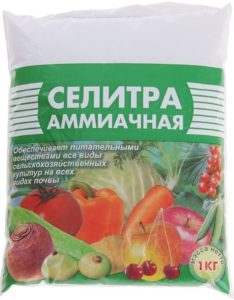
Content
What is ammonium nitrate: chemical composition and scope
Ammonium nitrate ranks second in popularity among mineral nitrogen fertilizers (the first is urea).
Ammonium nitrate contains nitrogen in two forms at once - ammonium (ammonia) and nitrate ... Chemical formula - NH4NO3, ammonium salt of nitric acid (ammonium nitrate).
Nitrogen content in ammonium nitrate - 33-35%.
Also, ammonium nitrate contains sulfur (3-14%).
Ammonium nitrate as a fertilizer is produced in granular form (usually white with a yellowish tinge).
Interesting! In fact, initially ammonium nitrate is a crystalline white substance, but in order to reduce dangerous properties (we will not name them) and reduce caking, various additives (phosphorite flour, gypsum, etc.) are introduced into it, which change its color, i.e. ... inhibit.
It is used as a nitrogen fertilizer for application under all crops by all means on almost all types of soils (read on for application and dosages below).
By the way! About,why are nitrogen fertilizers (including ammonium nitrate) needed (what is the use of them for plants), detailedin this material.
Varieties of ammonium nitrate
The most popular type of ammonium nitrate is calcium ammonium nitratewhich contains 26-28% nitrogen and at least 10% calcium (up to 20%).
The prefix "lime" means that ammonium nitrate calcified, i.e. neutralized acidity, fertilizer began to be exclusively neutral reaction.
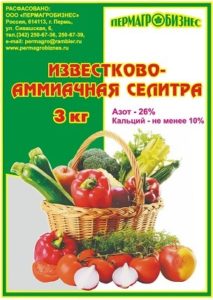
You can also find ammonium nitrate on sale. with trace elements (again with magnesium, boron, copper, iron, manganese and zinc).
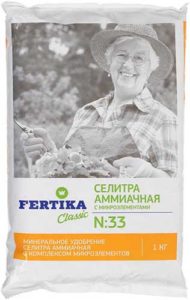
And there is also ammonium nitrate magnified (contains 5 to 10% magnesium).
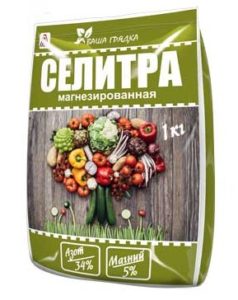
By the way! There is also potassium nitrate (13.6% nitrogen and 46% potassium) and calcium fertilizer (14.9% nitrogen and 27% calcium, as well as up to 4% sulfur).
When and how to use ammonia in the garden and vegetable garden: methods and rules of fertilization
Terms and methods of deposit
Ammonium nitrate can be applied in any way:
- For preparing the beds in autumn and spring (i.e. for the main application).
But it's better still in the spring, because nitrogen in nitrate form is washed out by precipitation.
Recall! Ammonium nitrate also contains nitrogen in the ammonium form, which is not washed out by precipitation.
- Pre-sowing application is also allowed (introduction into holes or grooves when sowing seeds or planting seedlings), while fertilizer granules must be mixed with the ground.
- For root and foliar feeding in the initial growing season, i.e. before flowering / beginning of fruiting (from April to mid-July).
However! For foliar dressing, ammonium nitrate is not recommended, because can burn leaves (in strong concentration).
Application rules
- Ammonium nitrate can be used in early spring, even on frozen soil, on which there is still snow (but optimally when it is already melting and at a positive temperature of +5 degrees).
Remember! When it's cold and in the snow introduced ammonium nitrate, after get warmer — urea.
- Ammonium nitrate fine dissolves in water (you can simply in water at room temperature or slightly warm, but optimally hot - 50-60 degrees).
- You can only spill liquid mineral fertilizers on the already wet ground (i.e. after watering) so as not to burn the roots of young plants.
- Overly concentrated ammonium nitrate solution can burn the leaves (unlike urea), therefore it is rarely used for foliar feeding (spraying on the leaves) and only according to the norm.
- Ammonium nitrate not necessarily embedded in soilsince nitrogen in ammonium and nitrate forms does not volatilize in air (unlike amide - urea).
- As we have already found out, ammonium nitrate contains nitrogen in ammonium and nitrate forms.As you know, nitrate fertilizers are easily washed out of the soil, but ammonium fertilizers are not, therefore introduction of ammonium nitrate in the autumn period is allowed, as well as in early spring in the snow.
Important! With heavy rainfall (frequent rains) and on light soils, nitrogen in the nitrate form can be washed out.
- Ammonium nitrate - enough fast-acting fertilizer that is easily absorbed by plantssince contains nitrogen in nitrate (the most rapidly assimilated form) and ammonium form.
- Ammonium nitrate - physiologically acidic fertilizer (chemically neutral), but it only temporarily and locally acidifies the soil, and even with its systematic use (especially for gray and chernozems, on such soils there will be no acidification at all).
However! On acidic soils, slight acidification still occurs with frequent use. Therefore, to neutralize the acidifying effect, together with ammonium nitrate, it is recommended add chalk, lime or dolomite flour, i.e. soil deoxidizers.
Or use calcium ammonium nitrate (already deoxidized fertilizer with neutral acidity).
- Accordingly, ammonium nitrate great for overly alkaline soils in order to increase their acidity (to shift the acidity to a more neutral reaction).
Note! Ammonium nitrate is not recommended mix (apply simultaneously) with alkaline (lime) fertilizers (soil deoxidizers), i.e. with chalk, lime, dolomite flour, wood ash, since when they interact, a chemical reaction will occur, which will lead to the loss of ammonia (nitrogen) and highlighting unpleasant odor which in turn can provoke ammonia plant poisoning = toxic shock (especially important for closed ground - greenhouses).
- On some packages of ammonium nitrate, you can often find the following very categorical advice: “It is forbidden to add ammonium nitrate for cucumbers, zucchini, squash and pumpkin, because promotes the accumulation of nitrates. "
However! Nitrates (more precisely, nitrites) primarily accumulate in vegetables under unfavorable conditions (poor lighting - lack of light, cool weather, lack of molybdenum). In any case, before fruiting, it is possible and even necessary to apply ammonium nitrate and other nitrogen fertilizers for pumpkin seeds (this is one of the most voracious crops).
Application rates
You can always find calculated dosages for fertilizing and feeding various crops with ammonium nitrate in the instructions on the package.
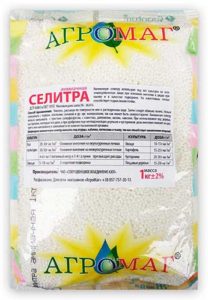
By the way! Recommended Ammonium Nitrate Dose for Most Crops - this 1 tbsp. spoon (12-15 grams) for 10 liters of water (for solution preparation) or for 1 square meter (in dry form for embedding in soil).
However, much more often they use matchbox (17-20 gr).
IN faceted glass - 170-200 gr.
To prepare the garden (scatter evenly over the surface and embed in the soil - by loosening and digging):
- For cultivated soils - 20-30 grams. per sq.m.
- For uncultivated soils - 30-50 gr. per sq.m.
Also can be used for introduction when planting seedlings (fertilizer granules must be mixed with soil): 3-4 grams per plant.
For root feeding (evenly distribute the plants around the trunk circle, carefully embed them in the soil, and then water. Or immediately prepare a solution for 10 liters of water and water):
- Vegetable crops - 10-20 gr. per sq.m. or 10 liters.
- Berry bushes - 20-30 gr. per square meter (for strawberries a little less - 15-20 gr).
Strawberries (garden strawberries) can be fed with urea 2 times — in spring and summer, immediately after harvest.
By the way! The site has an article about how to care for strawberries after fruiting.
- Fruit trees - 40-50 gr. per square meter (for a young tree, the trunk circle is usually about 1.5-2 square meters, for an older and fruitful tree - from 3 to 5 square meters).
Use or not use mineral nitrogen fertilizers for vegetable, fruit and berry crops, it's up to you! But if you decided everything (and did the right thing), then apply fertilizers correctly, on time and at the rate.
Video: ammonium nitrate

